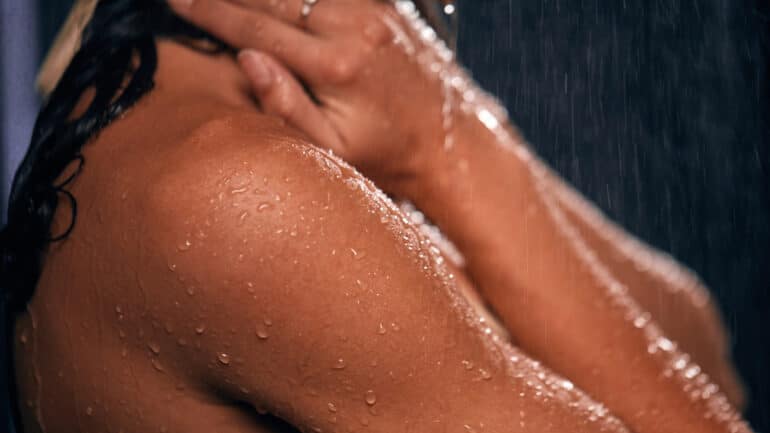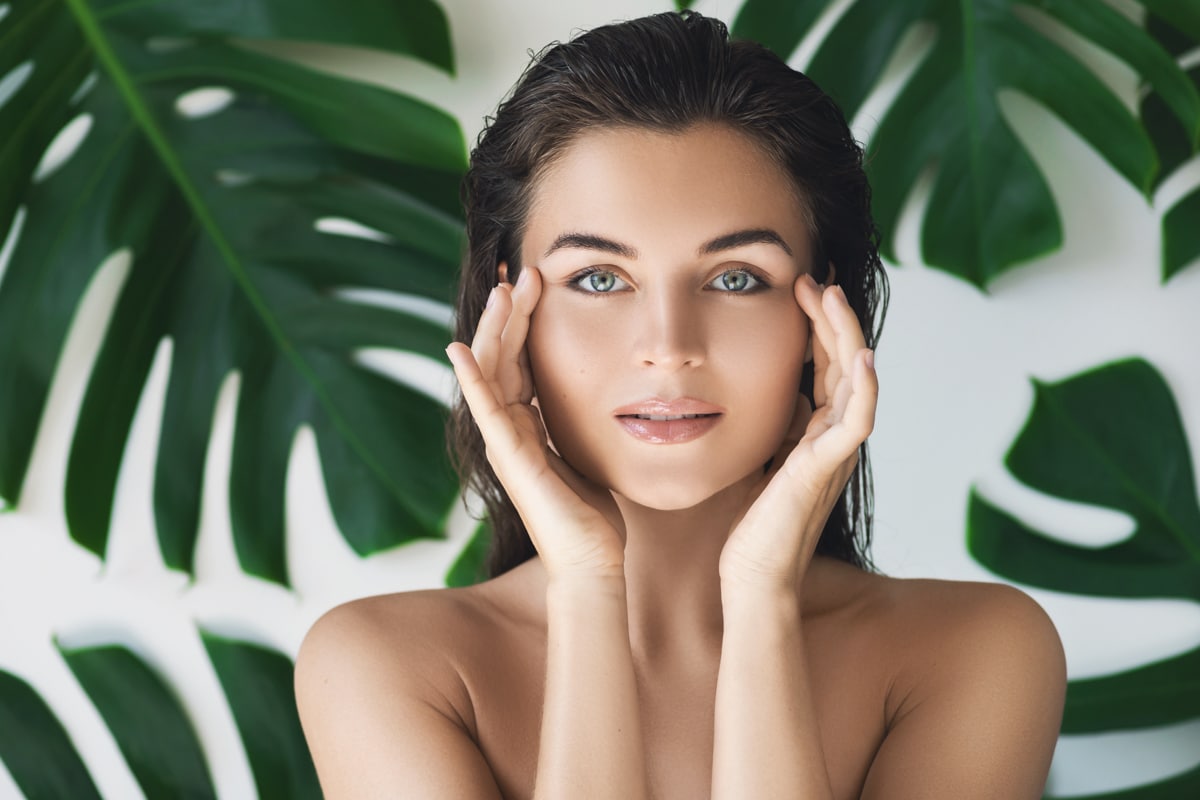Did you know the warm water faucet is on the left side of the sink because the right side was taken by cold before warm water was available since most people were right-handed? Tepid water (lukewarm water) definitely rinses the soap off your hands better when you wash. In fact, it’s thought to be optimal for your skin. You should experiment to find out the temperature that’s most comfortable for you, though. You’ll know you’ve got it right when it’s neither too cold nor too hot on the back of your hand.
Tepid water not only unclogs the pores but also helps maintain the natural oils of your skin while hot water strips them off and makes your skin dry. In turn, cold water doesn’t remove any oil or dirt trapped in your pores. As you can see, it’s all about attaining a balance. It sounds too simple to be true, right? Let’s see what scientists and personal experience have to say about it.
The Effects of Water on Your Skin
Every organ in your body, be it internal or external, needs water to function. According to this logic, you should be able to moisturize your skin just by putting water on it, right? We’ve all been told to wash our faces with plenty of soap and warm-to-hot water since we were children. However, while bar soap is bad enough as the chemicals in it dry out the skin, water on its own can also be damaging.
This is because water quickly evaporates when it comes into contact with the skin and takes many of the skin's natural oils with it, this is the so-called natural moisturizing factor. Thus, the more frequently you wash your skin, the drier it can get – especially if the water is too hot or chlorinated.
As you can see, you might be able to prevent dry skin by limiting its exposure to water although it’s just one of the many elements that bring about dry, flaky skin. Of course, this is kind of hard in your daily life as you go to the gym, use saunas, hot tubs, swim, and shower and many of these places contain chlorine. You can still be water smart when it comes to your daily skincare routine though.
What Exactly Is Tepid Water?
Depending on the source, the temperature of tepid water is between 100 and 110 degrees Fahrenheit although others say it’s between 98 and 105. Still, others believe that lukewarm means room temperature 72 to 74 Fahrenheit while others say it refers to the body temperature of 98.6 F. The official ANSI standard specifies 60 to 100 Fahrenheit and the international standard for safety showers and eye/face wash equipment, ANSI Z358.1-2014 specifies that water delivered by an emergency safety shower must be tepid.
Tepid Water: Choosing the Right Temperature for Your Skin
The consensus when it comes to the most optimal water temperature for your skin is it should be tepid. Of course, hot showers on a cold winter night are wonderful, but you must consider they strip the skin of its natural moisturizing factor faster than tepid water. Tepid is the same as lukewarm and doesn’t mean cold, only warm enough to be comfortable. You’ll know it’s too hot if your skin turns red upon contact.
Keep your showers short and lukewarm. Long, hot ones transform your bathroom into a spa-like experience, and while it might seem like a good idea to open your pores to clean them out they actually dry it out. Thus, use only enough of it to get you clean.
Likewise, you must use soap sparingly, don’t use it unless it is to remove dirt and grime. You don’t have to use it every time you shower either, try to use it only in those parts of your body you really want to refresh such as the armpits and private parts as these areas remain hidden, and tend to get moist and trap bacteria.
As you can see, it’s perfectly fine to keep the soap away from the rest of your body. Instead, switch to a soap formulated for dry skin or a liquid emollient body wash. Then, when it’s time to dry, pat your skin with a towel until the dripping stops. Don’t rub it as if you're trying to exfoliate it.
Ok, so you’ve followed all of the above steps, and your skin feels too dry after taking a shower. It’s time to change your cleanser, then. Be aware that the simple act of showering will dehydrate the skin to a certain degree so apply moisturizer to lock in hydration immediately after patting your skin dry. Also, be aware that dry skin is more common during the winter months. This is because the temperatures drop along with the humidity.
The Proper Way to Wash Your Face
According to the American Academy of Dermatology Association, the way you wash your face can improve your appearance. They offer the following tips to help you looking healthy and vibrant.
Firstly, use a gentle, non-abrasive cleanser that doesn't contain alcohol. Then, wet your face with lukewarm water and apply a cleanser with your fingertips, note that using anything other than your fingertips will irritate your skin. Thus, say no to scrubbing, it only irritates the skin. Finally, rinse with lukewarm water and pat dry with a soft towel.
Subsequently, apply a moisturizer if your skin is dry or itchy, keep it away from your eyes and other delicate areas of your face. Finally, don’t wash more than twice a day, when you wake up and before you go to bed unless your occupation is messy or sweaty. You may not be aware of it but perspiration irritates your skin, especially if you have to wear hats or protective equipment.
Not Too Hot and Not Too Cold
Face cleansing is now second nature for your morning and evening beauty routines. A little bit of soap here, a rinse there, a little moisturizer over there, and you’re ready to pat dry and move on to the next step. Had you ever thought about this process so mindfully? Do you ever take into account everything in it, from the amount of product you use to the water temperature you select?
Taking all of this for granted is normal; there are many other important things to think about. The thing is, going through the process of washing without actively thinking about it might negatively impact the rest of your routine. For example, a hot shower is quite cozy but washing your face in it is a no-no, same as washing it in very cold water.
The Effects of Hot Water On Your Skin
A hot and steamy shower during the wintertime makes you feel great at the moment so, of course, you prefer it. However, a dermatologist at Baylor College of Medicine says a hot bath or shower can lead to excessively dry skin. Thus, he recommends lukewarm baths and showers.
As we said above, the actual temperature of lukewarm or tepid water varies depending on whom you ask so trust your gut instincts and go with your individual preferences or tolerance. We already mentioned that showering in hot water during the wintery months dries out the skin but we didn’t mention it can also damage the skin surface. It could lead to skin inflammation and even increase eczema.
The most common signs of skin inflammation and eczema are redness, scaling and flaking, and itching.
You’ll notice it when you use thinner emollients like gels, lotions, and creams as these cause a stinging sensation when the skin is red and inflamed. Thus, it’s very important not to rub aggressively during a shower or a bath, as we mentioned above, and avoid fragrances and other common contact allergens as well.
Is Cold Water Better?
Ok, so that takes care of the hot water. How about cold water? Is it a better choice for washing? Well, not exactly. While hot water dilates your blood vessels in an effort to help cool you down, cold water does the opposite. Thus, the colder it is the more the flow of blood will restrict or decrease.
This automatic response is an effort your body makes to balance your temperature. So, the blood vessels constrict in an attempt to hold on to as much warmth as possible when you’re exposed to cold. Cold water won’t damage your skin but it’s too uncomfortable and there are no tangible benefits besides waking you up.
What’s the Importance of Tepid Water?
Tepid water has many important applications. For instance, many industries have safety showers to provide immediate relief to any employees splashed with hazardous chemicals. The water in these devices is delivered at a minimum of 20 gallons per minute for 15 minutes to provide enough time to wash the chemical from your skin and out of your eyes.
As you can imagine, a safety shower operating outside the lukewarm water range will further harm a person under the above circumstances. For example, water temperature above 100 Fahrenheit would scald said injured person and add water burns to their injuries, increasing their chance of absorbing the chemical into their skin.
In contrast, a safety shower with cold water would only make a person step away from it before completing the recommended 15 minutes of decontamination and expose them to ongoing chemical burns. Not only that, a cold safety shower could even induce hypothermia.
As you can see, water and temperature have a significant effect on the skin barrier. For one, water exposure impacts the skin, but even more when it’s hot. Thus, knowing the proper temperature to wash is one of the most important measures a person with skin inflammatory diseases can take to prevent flares.
There was an experimental technique developed to gain insight into the pathogenesis of warm-water immersion dermatoses. In it, certain skin parts of a group of people were continuously exposed to water for varying time periods. The purpose was to simulate actual exposures received by affected patients.
The clinical and histologic revelations of those exposed to water for 72 to 144 hours indicated intense subacute dermatitis. Thus, contrary to the researchers’ beliefs, the induction and intensity of responses didn’t depend upon increases in skin surface pH or bacterial population.
They didn’t notice post hydration anhidrosis (a rare condition in which the sweat glands make little or no sweat) or heat rash. However, hydration and maceration in the outermost layer of the epidermis were more pronounced. They concluded that the cause of dermatitis might be caused by water. However, it could also be caused by an unknown toxic natural surface substance.
The Impact of Water Exposure and Temperature Changes on Your Skin
We already mentioned how water exposure impairs skin barrier, hot water in particular. A study reflected an increase in the loss of water that goes from inside the body through the epidermis to the surrounding atmosphere via diffusion and evaporation) and pH (potential of hydrogen) values. Only direct contact with hot water showed skin barrier damage by increasing said water loss and erythema, a type of skin rash due to injured or inflamed blood capillaries.
The study reported skin barrier function changes after cold and hot water exposure and direct contact with cold and hot temperatures. They report that water exposure damages the skin barrier through several mechanisms. Also, that long exposure to water disrupts the barrier to water diffusion of the outermost layer of skin. Not only that, it induces swelling in certain areas along with the formation of large pools of water in the intercellular space.
Moreover, the study describes that water exposure causes changes in the shape of the skin barrier and increases hydration in a dose-dependent way. In turn, this facilitates the penetration of outside irritants or allergens and provides a suitable environment for bacterial overgrowth.
Not only that, they found a significant correlation between the aforementioned water loss and temperature, as the latter promotes the mass transfer of water from the outermost layer of the epidermis into the environment. It kind of explains why the water loss values mentioned above were higher after hot water exposure than after cold water exposure.
Water temperature is a significant factor that increases skin damage in those who wash frequently. Especially in these post-pandemic times as hand hygiene awareness greatly increased. You must keep in mind that higher water temperatures affect the structure of body fats.
Thus, the use of alcohol-based hand gels or gloves with wet hands is greatly discouraged as it increases the chance of trapping irritants that disrupt your skin barrier. The American Contact Dermatitis Society recommends washing them with cold or lukewarm water. In fact, the aforementioned study supports their recommendations because they didn’t only find that long and continuous water exposure damages the skin barrier but also that hot water is more aggressive than cold water.
This al means you should use cold or lukewarm water for washing and stay away from hot water. As with everything, we need further research that takes into account different water temperature ranges so as to find out what’s the exact and most ideal temperature for washing.
Water Temperature in Children
The study we mentioned above didn’t take children into consideration but the current guidelines for skincare in infants recommend washing them with a water temperature of 98.6−99.5 Fahrenheit. This is mainly based on expert opinion and there are no studies comparing skin barrier function impairment with different water temperatures in children.
Indeed, there might be differences in said skin barrier function and water impact between children and adults. This is because young skin undergoes a process of adaptation and maturation after a child is born.
Water Is Life
As you know, water is necessary for the survival of all living organisms. The human body is made up of about two-thirds of water and you cannot survive more than a few days without it. Thus, water is a precious substance that meets your physical needs. It has great spiritual importance to many people around the world as it’s an integral part of many ecosystems that support life.
As you can imagine, we must be sensitive about our water usage, and doing so is simpler than you think. For example, don’t leave the faucet running and install a low-flow faucet or aerator in the kitchen. You can also soak pots and pans before you wash them and only wash full loads of dishes in the dishwasher.
Take shorter showers and install a low-flush toilet, a low-flow faucet or aerator, and a low-flow showerhead. Also, turn off the tap while you shave, brush your teeth, or wash. Fix leaky faucets and toilets, buy an energy-efficient, water-saving washing machine, wash with colder water, and only wash full loads.
Finally, use a rain barrel to capture water for your garden, and don’t water your garden at midday on sunny days as most of that water will evaporate. Sweep your driveway and wash your car with a bucket instead of hosing them down. Use sprinklers that produce large water droplets; a mist or fine spray will simply evaporate. It's never too late to take conscience so, water you waiting for?










